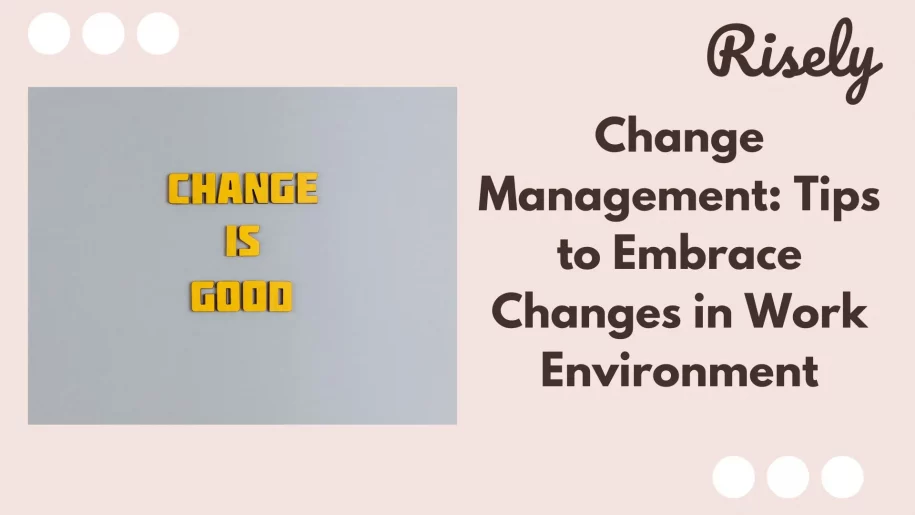Change Management: Tips to Embrace Changes in Work Environment
Change has become a constant companion in today’s dynamic and evolving workspace. The workplace is in flux, from technological advancements to market shifts and organizational transformations. Embracing change has become essential for individuals and organizations seeking to remain competitive and adaptable. In this blog, we’ll delve into the various aspects of changes at work, exploring why they occur, their impact, and how individuals and teams can navigate them successfully. Whether embracing new technologies, adapting to new work processes, or responding to shifts in market demands, understanding how to navigate changes effectively is a vital skill that can shape our careers and contribute to the success of our workplaces.What do changes in work mean?
“Changes in work” refers to modifications, shifts, or alterations in various workplace aspects. These changes can encompass various elements, including processes, policies, technologies, roles, responsibilities, organizational structures, and work environment. Evolving business needs, market trends, technological advancements, and employee feedback may drive them. These changes often aim to improve efficiency, adapt to new challenges, enhance employee satisfaction, and ultimately contribute to the organization’s success.Why are changes in work necessary?
Changes in work is essential for several reasons:- Adaptation to new realities: The businesses constantly evolve due to technological advancements, market shifts, and competitive pressures. Adapting to these changes ensures that the organization remains relevant and competitive.
- Innovation and growth: Embracing change fosters innovation by encouraging new ideas, processes, and strategies. It drives growth by opening up opportunities to expand into new markets or develop new products and services.
- Enhanced efficiency: Change in work often involves streamlining processes, adopting automation, and optimizing workflows. This leads to increased efficiency and reduced operational costs.
- Employee engagement: Involving employees in change initiatives can increase their engagement and job satisfaction. It shows that their input is valued and their growth is prioritized.
- Competitive advantage: Organizations that adapt to change quickly are better positioned to respond to market shifts and seize new opportunities, gaining a competitive edge.
- Risk mitigation: Changes can address potential risks and challenges before they escalate into larger problems, thus reducing the organization’s overall risk exposure.
- Employee development: Changes often require employees to learn new skills or perform different roles. This provides opportunities for professional growth and development.
Other Interesting Reads
Examples of changes in work
Examples of changes in work can vary across industries and organizations, but some common examples that illustrate how work can evolve:- Adoption of new technologies: Implementing new software, tools, or systems to automate tasks, improve efficiency, and enhance collaboration. For example, transitioning to cloud-based project management tools or customer relationship management (CRM) systems.
- Remote work policies: Introducing remote or flexible work arrangements to accommodate changing employee preferences and to adapt to external factors such as the pandemic.
- Process reengineering: Overhauling existing processes to eliminate inefficiencies and reduce bottlenecks. This could involve rethinking workflows or new methodologies.
- Performance management changes: Moving away from traditional annual performance reviews to more frequent feedback loops and continuous performance management.
- Digital transformation: Shifting from manual or paper-based processes to digital workflows, improving data accuracy and accessibility.
Tips for dealing with changes in work
Coping with changes in work requires a combination of adaptability, resilience, and a proactive mindset. Some tips to help you effectively cope with changes in the workplace:- Stay informed: Seek out information about the upcoming changes. Understand the reasons behind the changes, the goals, and the expected outcomes. This knowledge can help reduce uncertainty and anxiety.
- Maintain a positive attitude: Embrace a positive attitude towards change. Focus on the potential benefits and opportunities the changes may bring rather than dwelling on the challenges.
- Flexibility: Be open to adapting your routines, processes, and approaches. Flexibility allows you to navigate changes with greater ease and less resistance.
- Seek support: Reach out to colleagues, mentors, or supervisors for guidance and support. Discussing your concerns with others can provide insights and perspective.
- Develop resilience: Cultivate resilience by building your ability to bounce back from setbacks. Practice stress management techniques, maintain a healthy work-life balance, and engage in activities that rejuvenate you.
- Learn continuously: Embrace a growth mindset and view changes as opportunities to learn new skills and expand your knowledge. Seek out training or upskilling opportunities that align with the changes.
- Communicate effectively: Communicate openly with your colleagues, supervisors, and teams about your concerns, questions, and feedback. Effective communication can ease the transition and foster a supportive environment.
- Take the initiative: Proactively involve yourself in the change process. Offer suggestions, participate in discussions, and take ownership of your role in implementing the changes.
- Stay organized: Use tools like calendars, to-do lists, and project management software to keep track of tasks related to the changes. Organizing your responsibilities can reduce stress.
- Be patient: Adjusting to changes takes time. Be patient with yourself and others as you navigate the transition.
- Reflect and learn: After implementing the changes, reflect on what you’ve learned from the experience. Assess what worked well and what could be improved for future changes.
Steps L&D managers can take to help employees deal with changes in work
L&D (Learning and Development) managers play a crucial role in helping employees deal with changes at work. Steps they can take to support employees during times of change Preparation and communication:- Provide advance notice of upcoming changes whenever possible.
- Communicate the reasons behind the changes and how they align with the organization’s goals.
- Address potential concerns and questions through transparent and open communication.
- Identify the new skills and knowledge required due to the changes.
- Offer targeted training programs or workshops to help employees acquire the necessary skills.
- If needed, provide access to learning resources, online courses, or external training.
- Develop personalized learning plans for each employee based on their roles and the changes they will face.
- Tailor learning experiences to address specific challenges arising from the changes.
- Provide employees with resources like job aids, reference guides, and tutorials to assist them in adapting to new processes or technologies.
- Assign mentors or coaches who can guide employees through the changes and offer one-on-one support.
- Create a safe space for employees to discuss their concerns and seek guidance.
- Establish feedback mechanisms where employees can express their thoughts, concerns, and suggestions regarding the changes.
- Use feedback to refine the change implementation process and address any challenges.
- Cultivate a continuous learning and adaptability culture, where employees are encouraged to embrace change as an opportunity for growth.
Conclusion
In conclusion, change is an integral part of the modern work environment, and our ability to navigate and embrace it can make a significant difference in our personal and professional growth. As we’ve explored, work changes can be challenging and rewarding. They offer opportunities to learn new skills, expand our knowledge, and contribute to the overall success of our organizations. By approaching changes with an open mind, a positive attitude, and a willingness to adapt, we can survive and thrive in the face of evolving circumstances. Remember, change is not just a disruption; it’s a chance to innovate, collaborate, and create a better future for ourselves and our workplaces. So, let’s embrace change as a catalyst for progress and continue to evolve, learn, and succeed in our dynamic and ever-changing work environments.Ready to thrive in a changing work landscape?
Take our free goal-setting assessment and equip yourself with the tools to set and achieve your professional milestones amidst evolving circumstances.
Other Related Blogs
Manager Development Goals And How To Reach Them: Opportunities And Areas To Focus On
Manager Development Goals And How To Reach Them: Opportunities And Areas To Focus On You’ve meticulously crafted a development program for your high-potential employees, but their managers just aren’t on…
Leader Competence: The Cornerstone of Effective Leadership Development
Leader Competence: The Cornerstone of Effective Leadership Development Imagine you’re leading a talented team, but somehow, projects are stalling, and motivation seems slipping. You see the potential in your people,…
Leading Beyond Lines: Dhun Chhokar’s Journey from Design to Management
Leading Beyond Lines: Dhun Chhokar’s Journey from Design to Management Remember the time when you were jittery and nervous about your career and were seeking advice from everyone? We’ve all…
Boost Your Confidence and Communication: Top 4 Assertiveness Training Activities
Boost Your Confidence and Communication: Top 4 Assertiveness Training Activities It’s Tuesday morning, and you’re meeting with your team. A colleague proposes an approach you disagree with but hesitates to…


